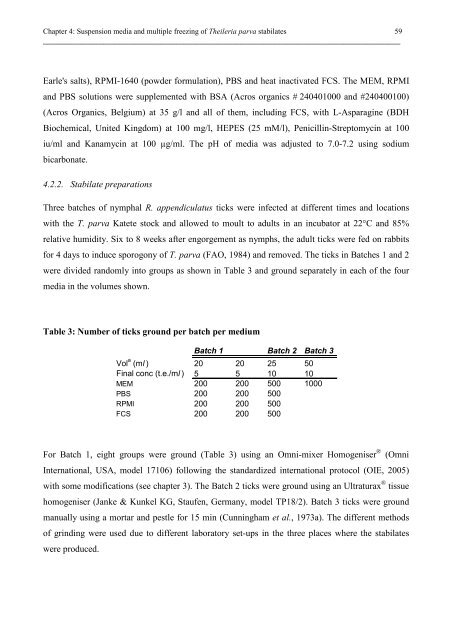In vitro quantitation of Theileria parva sporozoites for use - TropMed ...
In vitro quantitation of Theileria parva sporozoites for use - TropMed ...
In vitro quantitation of Theileria parva sporozoites for use - TropMed ...
Create successful ePaper yourself
Turn your PDF publications into a flip-book with our unique Google optimized e-Paper software.
Chapter 4: Suspension media and multiple freezing <strong>of</strong> <strong>Theileria</strong> <strong>parva</strong> stabilates 59<br />
______________________________________________________________________________________________<br />
Earle's salts), RPMI-1640 (powder <strong>for</strong>mulation), PBS and heat inactivated FCS. The MEM, RPMI<br />
and PBS solutions were supplemented with BSA (Acros organics # 240401000 and #240400100)<br />
(Acros Organics, Belgium) at 35 g/l and all <strong>of</strong> them, including FCS, with L-Asparagine (BDH<br />
Biochemical, United Kingdom) at 100 mg/l, HEPES (25 mM/l), Penicillin-Streptomycin at 100<br />
iu/ml and Kanamycin at 100 µg/ml. The pH <strong>of</strong> media was adjusted to 7.0-7.2 using sodium<br />
bicarbonate.<br />
4.2.2. Stabilate preparations<br />
Three batches <strong>of</strong> nymphal R. appendiculatus ticks were infected at different times and locations<br />
with the T. <strong>parva</strong> Katete stock and allowed to moult to adults in an incubator at 22°C and 85%<br />
relative humidity. Six to 8 weeks after engorgement as nymphs, the adult ticks were fed on rabbits<br />
<strong>for</strong> 4 days to induce sporogony <strong>of</strong> T. <strong>parva</strong> (FAO, 1984) and removed. The ticks in Batches 1 and 2<br />
were divided randomly into groups as shown in Table 3 and ground separately in each <strong>of</strong> the four<br />
media in the volumes shown.<br />
Table 3: Number <strong>of</strong> ticks ground per batch per medium<br />
Batch 1<br />
Batch 2 Batch 3<br />
Vol a (ml ) 20 20 25 50<br />
Final conc (t.e./ml ) 5 5 10 10<br />
MEM 200 200 500 1000<br />
PBS 200 200 500<br />
RPMI 200 200 500<br />
FCS 200 200 500<br />
For Batch 1, eight groups were ground (Table 3) using an Omni-mixer Homogeniser ® (Omni<br />
<strong>In</strong>ternational, USA, model 17106) following the standardized international protocol (OIE, 2005)<br />
with some modifications (see chapter 3). The Batch 2 ticks were ground using an Ultraturax ® tissue<br />
homogeniser (Janke & Kunkel KG, Staufen, Germany, model TP18/2). Batch 3 ticks were ground<br />
manually using a mortar and pestle <strong>for</strong> 15 min (Cunningham et al., 1973a). The different methods<br />
<strong>of</strong> grinding were <strong>use</strong>d due to different laboratory set-ups in the three places where the stabilates<br />
were produced.











